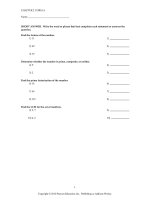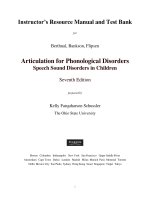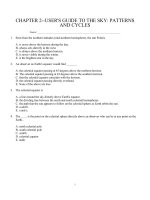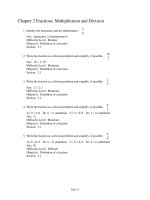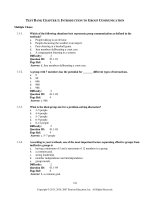Sociology in modules 2nd edition schaefer test bank
Bạn đang xem bản rút gọn của tài liệu. Xem và tải ngay bản đầy đủ của tài liệu tại đây (85.85 KB, 29 trang )
Chapter 02 - Sociological Research
Chapter 02
Sociological Research
Multiple Choice Questions
1. Adler and Adler's work on self-injury reflects which of the three major sociological
approaches?
A. functionalist perspective
B. conflict perspective
C. interactionist perspective
D. reflects all three perspectives
Type: P
2. Which one of the following statements is true regarding the subjects of Adler and Adler's
study of self-injurers?
A. Most begin injuring in secret.
B. They are a homogeneous group.
C. Behavior is carefully planned.
D. Most eventually "grow out of it".
Type: P
3. Adler and Adler studied:
A. suicide
B. self-injury
C. spousal abuse
D. college students
Type: I
2-1
© 2013 by McGraw-Hill Education. This is proprietary material solely for authorized instructor use. Not authorized for sale or distribution in
any manner. This document may not be copied, scanned, duplicated, forwarded, distributed, or posted on a website, in whole or part
Chapter 02 - Sociological Research
4. Which of the following terms is used to describe a systematic, organized series of steps that
ensures maximum objectivity and consistency in researching a problem?
A. scientific method
B. social science
C. experiment
D. value neutrality
Type: D
5. What is commonly the second step in the scientific method?
A. defining the problem
B. selecting the research design
C. reviewing the literature
D. collecting and analyzing data
Type: I
6. If you were interested in studying the relationship between date and acquaintance rape
victims and the characteristics of the rapist, your first step would be to:
A. review the literature on date and acquaintance rape.
B. define the problem.
C. create a hypothesis.
D. choose a research design.
Type: C
7. After a sociologist reviews the literature, what is the next step in the process?
A. review the literature on date and acquaintance rape
B. ideas for future research
C. create a hypothesis
D. choose a research design
Type: C
2-2
© 2013 by McGraw-Hill Education. This is proprietary material solely for authorized instructor use. Not authorized for sale or distribution in
any manner. This document may not be copied, scanned, duplicated, forwarded, distributed, or posted on a website, in whole or part
Chapter 02 - Sociological Research
8. An operational definition is:
A. a speculative statement about the relationship between two variables.
B. the extent to which a measure provides consistent results.
C. an explanation of an abstract concept that is specific enough to allow a researcher to measure
the concept.
D. a relationship between two variables whereby a change in one coincides with a change in the
other.
Type: D
9. Which operational definition does Schaefer use in his research example to illustrate the
scientific method?
A. recreation and work
B. prejudice and education
C. social clubs and status
D. education and earnings
Type: I
10. A sociologist who is interested in examining racism in sports might determine what
percentage of team owners, general managers, coaches, and managers are members of each
racial group. This would be an example of developing a(an)
A. research design.
B. operational definition.
C. hypothesis.
D. theory.
Type: C
2-3
© 2013 by McGraw-Hill Education. This is proprietary material solely for authorized instructor use. Not authorized for sale or distribution in
any manner. This document may not be copied, scanned, duplicated, forwarded, distributed, or posted on a website, in whole or part
Chapter 02 - Sociological Research
11. Which sociological perspective would most likely suggest that education is necessary for
people to earn more money and advance in society for the purpose of social stability?
A. functionalist perspective
B. conflict perspective
C. interactionist perspective
D. feminist perspective
Type: P
12. What sociological perspective would most likely suggest that educational inequalities are
purposeful and set up to reinforce the position of those in power?
A. functionalist perspective
B. conflict perspective
C. interactionist perspective
D. feminist perspective
Type: P
13. Sociologists conduct a "review of the literature" to
A. refine the problem under study.
B. clarify possible techniques to be used in collecting data.
C. eliminate or reduce the number of avoidable mistakes they make.
D. all of these
Type: I
14. A speculative statement about the relationship between two or more variables is known as a
A. correlation.
B. hypothesis.
C. sample.
D. research design.
Type: D
2-4
© 2013 by McGraw-Hill Education. This is proprietary material solely for authorized instructor use. Not authorized for sale or distribution in
any manner. This document may not be copied, scanned, duplicated, forwarded, distributed, or posted on a website, in whole or part
Chapter 02 - Sociological Research
15. Which of the following best describes the notion that the higher the level of one's education,
the higher one's income level will be?
A. independent variables
B. operational definition
C. hypothesis
D. none of these
Type: C
16. The statement "Women who receive welfare are less likely than other women to have
babies" is an example of
A. an operational definition.
B. a hypothesis.
C. a research design.
D. causal logic.
Type: C
17. A researcher finds that those who have children at a young age are significantly more likely
to have lower levels of education. This would be an example of:
A. a hypothesis
B. a correlation
C. a cause
D. an effect
Type: C
18. The statement "Most homeless people are not mentally ill" is an example of a(an)
A. hypothesis.
B. experiment.
C. operational definition.
D. variable.
Type: C
2-5
© 2013 by McGraw-Hill Education. This is proprietary material solely for authorized instructor use. Not authorized for sale or distribution in
any manner. This document may not be copied, scanned, duplicated, forwarded, distributed, or posted on a website, in whole or part
Chapter 02 - Sociological Research
19. A variable is
A. a measurable trait or characteristic that is subject to change under different conditions.
B. the extent to which a measure provides consistent results.
C. the unintended influence that observers or experiments can have on their subjects.
D. a speculative statement about the relationship between two traits.
Type: D
20. Income, religion, race, gender, and marital status can all be examples of
A. indexes.
B. scales.
C. variables.
D. operational definitions.
Type: C
21. Which of the following can serve as a variable in a study?
A. marital status
B. ethnic background
C. age
D. all of these
Type: C
22. Which of the following would be considered the independent variable in the text research
example cited by Schaefer in Chapter 2?
A. level of education
B. level of income
C. sources of income
D. all of these
Type: I
2-6
© 2013 by McGraw-Hill Education. This is proprietary material solely for authorized instructor use. Not authorized for sale or distribution in
any manner. This document may not be copied, scanned, duplicated, forwarded, distributed, or posted on a website, in whole or part
Chapter 02 - Sociological Research
23. Social scientists call the variable that is hypothesized to cause or influence another variable
a(an)
A. independent variable.
B. dependent variable.
C. spurious variable.
D. operational variable.
Type: D
24. Researchers find that pet owners live longer, healthier lives. Within this study pet
ownership is the:
A. independent variable.
B. dependent variable.
C. spurious variable.
D. operational variable.
Type: C
25. Sociological studies have indicated that people who are married are less likely to commit
suicide than people who are divorced. In this example, marital status is a(an)
A. hypothesis.
B. independent variable.
C. dependent variable.
D. index.
Type: C
26. Sociological studies have indicated that people who are married are less likely to commit
suicide than people who are divorced. In this example, suicide is a(an)
A. hypothesis.
B. independent variable.
C. dependent variable.
D. index.
Type: C
2-7
© 2013 by McGraw-Hill Education. This is proprietary material solely for authorized instructor use. Not authorized for sale or distribution in
any manner. This document may not be copied, scanned, duplicated, forwarded, distributed, or posted on a website, in whole or part
Chapter 02 - Sociological Research
27. The race of a criminal offender is associated with the frequency with which capital
punishment is administered. In this example, capital punishment would be considered the
A. hypothesis.
B. independent variable.
C. dependent variable.
D. index.
Type: C
28. The relationship between a condition or a variable and a particular consequence, with one
event leading to the other, is known as
A. observation.
B. causal logic.
C. a correlation.
D. an index.
Type: D
29. The statement "People who live in poverty have shorter life expectancies than wealthier
citizens" is an example of
A. causal logic.
B. a correlation.
C. an independent variable.
D. the Hawthorne effect.
Type: C
30. The statement "Eating fewer fats and carbohydrates will lead to weight loss" is an example
of
A. causal logic.
B. a dependent variable.
C. an independent variable.
D. a cross tabulation.
Type: C
2-8
© 2013 by McGraw-Hill Education. This is proprietary material solely for authorized instructor use. Not authorized for sale or distribution in
any manner. This document may not be copied, scanned, duplicated, forwarded, distributed, or posted on a website, in whole or part
Chapter 02 - Sociological Research
31. The greater likelihood of a person who is less integrated into society committing suicide
illustrates
A. a defined variable.
B. an undefined variable.
C. causal logic.
D. a social fact.
Type: D
32. The relationship between two variables whereby a change in one coincides with a change in
the other is known as a(an)
A. index.
B. correlation.
C. operational definition.
D. scale.
Type: D
33. Individuals who have divorced parents are more likely to divorce than individuals who have
parents who did not divorce. This statement is an example of a(an)
A. theory.
B. correlation.
C. independent variable.
D. law.
Type: C
34. In which type of sample does each member of the entire population being studied have the
same chance of being selected?
A. random sample
B. quota sample
C. index sample
D. Roper sample
Type: D
2-9
© 2013 by McGraw-Hill Education. This is proprietary material solely for authorized instructor use. Not authorized for sale or distribution in
any manner. This document may not be copied, scanned, duplicated, forwarded, distributed, or posted on a website, in whole or part
Chapter 02 - Sociological Research
35. If researchers wanted to examine the opinions of people listed in a city directory, they might
call every tenth or fiftieth or hundredth name listed. This would constitute a
A. scale.
B. control variable.
C. quota sample.
D. random sample.
Type: C
36. A research measure that provides consistent results is considered
A. valid.
B. reliable.
C. an index.
D. a scale.
Type: D
37. Valid research measures
A. provide consistent results.
B. are always independent, rather than dependent, variables.
C. accurately measure the phenomenon under study.
D. are ethical standards that are followed by sociologists.
Type: I
38. Which of the following would be considered a valid measure of an individual's
intelligence?
A. his or her age
B. the researcher's opinion
C. the number of years of school that the individual has completed
D. none of these
Type: C
2-10
© 2013 by McGraw-Hill Education. This is proprietary material solely for authorized instructor use. Not authorized for sale or distribution in
any manner. This document may not be copied, scanned, duplicated, forwarded, distributed, or posted on a website, in whole or part
Chapter 02 - Sociological Research
39. What type of sample would a researcher employ in order to study illegal drug users?
A. snowball sample
B. random sample
C. convenience sample
D. snowball sample AND convenience sample
Type: C
40. What was the source of the data collected in the research example given by Schaefer in
Chapter 2?
A. city directories
B. the Current Population Survey
C. phone surveys
D. college and university surveys
Type: I
41. A factor held constant to test the relative impact of the independent variable is known as a
A. control variable.
B. dependent variable.
C. correlation.
D. cross-tabulation.
Type: D
42. A research design is a(an):
A. explanation of an abstract concept that is specific enough to allow a researcher to measure
the concept.
B. speculative statement about the relationship between two or more variables.
C. indicator of attitudes, behavior, or characteristics of people or organizations.
D. detailed plan or method for scientifically obtaining data.
Type: D
2-11
© 2013 by McGraw-Hill Education. This is proprietary material solely for authorized instructor use. Not authorized for sale or distribution in
any manner. This document may not be copied, scanned, duplicated, forwarded, distributed, or posted on a website, in whole or part
Chapter 02 - Sociological Research
43. Selecting a research design is important because it may affect both the amount of time and
the
A. validity of the study.
B. cost of the project.
C. reliability of the study.
D. scale of the project.
Type: I
44. A study, generally in the form of an interview or a questionnaire that provides sociologists
with information concerning how people think or act is known as
A. observation research.
B. a survey.
C. secondary analysis.
D. an experiment.
Type: D
45. To conduct a cross-cultural study of job discrimination against women, a sociologist
interviews 75 women between the ages of 20 and 40 in an American city, and 75 women in the
same age group in a Canadian city. This study would be classified as
A. a secondary analysis.
B. participant observation.
C. a survey.
D. a content analysis.
Type: C
2-12
© 2013 by McGraw-Hill Education. This is proprietary material solely for authorized instructor use. Not authorized for sale or distribution in
any manner. This document may not be copied, scanned, duplicated, forwarded, distributed, or posted on a website, in whole or part
Chapter 02 - Sociological Research
46. Surveys and interviews that focus on macrosociological analyses would be likely to follow
which theoretical perspective?
A. functionalist perspective
B. conflict perspective
C. interactionist perspective
D. both functionalist and conflict perspectives
Type: P
47. The results of an interview may be influenced by
A. the gender of the interviewer.
B. the race of the interviewer.
C. neither gender nor race of the interviewer.
D. both gender and race of the interviewer.
Type: I
48. Observation research is the most common form of _____________ research, which relies
on what is seen in the field and in naturalistic settings more than it does on statistical data.
A. quantitative
B. qualitative
C. ethnographic
D. experimental
Type: D
49. What method can researchers employ in order to counter bias in their sampling?
A. snowball sampling
B. weighting
C. convenience sample
D. non-random surveying
Type: I
2-13
© 2013 by McGraw-Hill Education. This is proprietary material solely for authorized instructor use. Not authorized for sale or distribution in
any manner. This document may not be copied, scanned, duplicated, forwarded, distributed, or posted on a website, in whole or part
Chapter 02 - Sociological Research
50. Researchers found which of the following to be true of cell phone users compared to
landline users?
A. more likely to screen incoming calls
B. more likely to break off a call mid-survey
C. higher proportion of non-adults on cell phones
D. all of these
Type: I
51. When a researcher collects information about a group through direct involvement and
inspection, this is known as
A. a survey.
B. observation.
C. secondary analysis.
D. an experiment.
Type: D
52. A sociologist attends meetings at all the schools and churches in his community over
several years, and meets as many residents as he can for the purpose of exploring all facets of
the community's social life. He then compiles a detailed description of the community. He is
conducting a(an)
A. content analysis.
B. secondary analysis.
C. quantitative study.
D. ethnography.
Type: C
2-14
© 2013 by McGraw-Hill Education. This is proprietary material solely for authorized instructor use. Not authorized for sale or distribution in
any manner. This document may not be copied, scanned, duplicated, forwarded, distributed, or posted on a website, in whole or part
Chapter 02 - Sociological Research
53. The initial challenge that William F. Whyte and other participant observers encounter is
A. maintaining their objectivity when studying people face-to-face.
B. formulating the sequence of questions in an interview.
C. determining which group will be the experimental group.
D. gaining acceptance into an unfamiliar group.
Type: I
54. ___________'s study of Italian street-corner men used participant observation.
A. Terry Mizrahi
B. William F. Whyte
C. Max Weber
D. Vilfredo Pareto
Type: S
55. When a sociologist actually joins a group for a period to get an accurate sense of how it
operates, the approach is called
A. an experiment.
B. ethnography.
C. face-to-face interview.
D. participant observation.
Type: P
56. Which of the following was not one of the goals of social scientists embedded with the U.S.
military in Afghanistan and Iraq?
A. identify local customs
B. report on kinship structures
C. conduct experiments on local communities
D. identify local internal social conflicts
Type: I
2-15
© 2013 by McGraw-Hill Education. This is proprietary material solely for authorized instructor use. Not authorized for sale or distribution in
any manner. This document may not be copied, scanned, duplicated, forwarded, distributed, or posted on a website, in whole or part
Chapter 02 - Sociological Research
57. An artificially created situation that allows the researcher to manipulate variables and to
introduce control variables is known as a(an)
A. survey.
B. experiment.
C. replication.
D. research design.
Type: D
58. In an experiment, the group that is not exposed to the independent variable is called the
A. experimental group.
B. representative group.
C. study group.
D. control group.
Type: D
59. A sociologist sets up an experiment on television violence and children. She shows one set
of children (group A) violent cartoons and then observes their play. She shows a second set of
children (group B) non-violent cartoons and then observes their play. Which of these groups
would be considered the experimental group?
A. Group A
B. Group B
C. Neither group
D. Both groups
Type: C
2-16
© 2013 by McGraw-Hill Education. This is proprietary material solely for authorized instructor use. Not authorized for sale or distribution in
any manner. This document may not be copied, scanned, duplicated, forwarded, distributed, or posted on a website, in whole or part
Chapter 02 - Sociological Research
60. People may behave differently in artificial situations than they would in the "real world".
This poses a particular problem for researchers using
A. questionnaires.
B. content analysis.
C. replication.
D. laboratory experiments.
Type: I
61. Regina wants to study the homeless in her hometown. In order to do so, she lives at a
homeless shelter for a month. During this time, she does everything that the women she is
studying does and tells no one of her true identity. This methos would be:
A. an experiment.
B. ethnography.
C. face-to-face interview.
D. participant observation.
Type: C
62. What term do sociologists use to describe the phenomenon whereby subjects deviate from
their typical behavior because they realize they are under observation?
A. the control group effect
B. the spurious response
C. the Hawthorne effect
D. skewing
Type: I
2-17
© 2013 by McGraw-Hill Education. This is proprietary material solely for authorized instructor use. Not authorized for sale or distribution in
any manner. This document may not be copied, scanned, duplicated, forwarded, distributed, or posted on a website, in whole or part
Chapter 02 - Sociological Research
63. A sociologist decides to study the interaction among students in the college's computer
center. When the students realize they are under observation, they become shy and reserved in
their interactions. This is an example of
A. replication.
B. secondary analysis.
C. the Hawthorne effect.
D. value neutrality.
Type: C
64. Secondary analysis includes a variety of research techniques that use
A. questionnaires and interviews.
B. participant observation.
C. publicly accessible information and data, or data collected by another.
D. control groups.
Type: D
65. Information on historical naming trends discussed in Chapter 2 illustrates the fact that
A. Americans use the same names over and over.
B. names for boys and girls do not vary by race and ethnicity.
C. available information can be used for sociological research.
D. secondary research is just for fun.
Type: P
66. Sociologists consider secondary analysis to be
A. more valid than other forms of research.
B. more reliable than other forms of research.
C. a nonreactive form of research.
D. an outdated mode of research.
Type: I
2-18
© 2013 by McGraw-Hill Education. This is proprietary material solely for authorized instructor use. Not authorized for sale or distribution in
any manner. This document may not be copied, scanned, duplicated, forwarded, distributed, or posted on a website, in whole or part
Chapter 02 - Sociological Research
67. Which of the following sociologists conducted an examination of suicide using secondary
analysis?
A. Max Weber
B. Émile Durkheim
C. Jane Poulsen
D. William F. Whyte
Type: S
68. An inherent problem in using secondary sources of data is that
A. the researcher may not find the exact data needed for his/her own research.
B. the data are plagued with statistical errors.
C. the researcher may be more careless when using someone else's data.
D. all of the analysis has been completed by an initial research team.
Type: I
69. A researcher studies adolescent attitudes about senior citizens by analyzing depictions of
the elderly in the lyrics of popular music and the content of teen magazines. This is an example
of
A. content analysis.
B. replication.
C. survey research.
D. an experiment.
Type: C
70. When was sociology's code of ethics first published?
A. 1871
B. 1917
C. 1947
D. 1971
Type: S
2-19
© 2013 by McGraw-Hill Education. This is proprietary material solely for authorized instructor use. Not authorized for sale or distribution in
any manner. This document may not be copied, scanned, duplicated, forwarded, distributed, or posted on a website, in whole or part
Chapter 02 - Sociological Research
71. The code of ethics for the discipline of sociology was developed by
A. Max Weber.
B. the U.S. Department of Education.
C. the American Association of University Professors.
D. the American Sociological Association.
Type: I
72. Which of the following is included in the code of ethics for sociology?
A. maintaining confidentiality
B. objectivity and integrity in research
C. protection of research subjects from personal harm
D. all of these
Type: I
73. Which of the following is not incorporated into the basic principles of the code of ethics for
sociology?
A. a required number of data sources
B. respect for subjects' privacy
C. acknowledgment of research collaboration
D. disclosure of sources of financial support
Type: I
74. Which of the following existing data sources are used more frequently for sociological
research?
A. census data
B. scientific records
C. personal journals
D. newspapers
Type: I
2-20
© 2013 by McGraw-Hill Education. This is proprietary material solely for authorized instructor use. Not authorized for sale or distribution in
any manner. This document may not be copied, scanned, duplicated, forwarded, distributed, or posted on a website, in whole or part
Chapter 02 - Sociological Research
75. Why was Rik Scarce, a doctoral student at Washington State University, placed in jail in
1993?
A. for preserving the confidentiality of his research
B. for raiding a university laboratory
C. for "snitching" on university administrators
D. for forging transcripts
Type: D
76. Which of the following is true regarding actions by the Exxon Corporation after the 1989
Valdez disaster?
A. Exxon solicited sociologists to do research on jury deliberations.
B. Exxon offered research money for sociologists doing research on jury deliberations.
C. Some of the research funded by Exxon was published in peer-reviewed journals.
D. all of these
Type: I
77. Which of the following does your textbook note as a common criticism of Exxon's actions
after the 1989 Valdez disaster?
A. Exxon didn't pay sociologists well enough for the research they did on jury deliberations.
B. Exxon agreed to fund only those sociologists who were known to be in favor of Exxon's
policies and actions.
C. No legal scholars were approached to do research on jury deliberations.
D. Exxon didn't volunteer to fund research on clean-up technologies or long-term
environmental costs.
Type: I
2-21
© 2013 by McGraw-Hill Education. This is proprietary material solely for authorized instructor use. Not authorized for sale or distribution in
any manner. This document may not be copied, scanned, duplicated, forwarded, distributed, or posted on a website, in whole or part
Chapter 02 - Sociological Research
78. "Value neutrality" in social science research was initially called for by
A. Émile Durkheim.
B. W.E.B. Du Bois.
C. Max Weber.
D. William Zellner.
Type: S
79. According to Max Weber, investigators have an ethical obligation to accept research
findings even when the data run counter to
A. their own personal views.
B. theoretically based explanations.
C. widely accepted beliefs.
D. all of these
Type: I
80. The Death of White Sociology, which called attention to the tendency of mainstream
sociology to treat the lives of African Americans as a social problem, was written by
A. Erving Goffman.
B. Alvin Gouldner.
C. Joyce Ladner.
D. Shulamit Reinharz.
Type: S
81. Which sociologist argued that sociological research should focus on social change and on
relevant research developed by nonsociologists?
A. Jane Poulson
B. Joyce Ladner
C. Shulamit Reinharz
D. Karen Barkey
Type: S
2-22
© 2013 by McGraw-Hill Education. This is proprietary material solely for authorized instructor use. Not authorized for sale or distribution in
any manner. This document may not be copied, scanned, duplicated, forwarded, distributed, or posted on a website, in whole or part
Chapter 02 - Sociological Research
82. After the conclusion of his/her research on the homeless in Chicago, which sociologist
stated that "in the short term, good social research will often be greeted as a betrayal of one or
another side"?
A. Erving Goffman
B. Alvin Gouldner
C. Joyce Ladner
D. Peter Rossi
Type: I
83. Which of the following locations traditionally would be of interest to a feminist researcher?
A. playgrounds
B. grocery stores
C. front stoops
D. all of these
Type: I
84. Feminist researchers would be most interested in which of the following aspects of global
research?
A. industrial nations' GDP as related to exports
B. global trafficking of sex workers
C. how multinational corporations fit into world-systems theory
D. the role of poor men in terrorist activities
Type: I
85. Which of the following is true regarding feminist researchers?
A. tend to involve and consult subjects more
B. more oriented towards seeking change
C. want to raise public consciousness
D. all of these
Type: I
2-23
© 2013 by McGraw-Hill Education. This is proprietary material solely for authorized instructor use. Not authorized for sale or distribution in
any manner. This document may not be copied, scanned, duplicated, forwarded, distributed, or posted on a website, in whole or part
Chapter 02 - Sociological Research
86. What is a potential problem when sending out Internet-based surveys?
A. protection of the respondent's anonymity
B. defining the potential audience
C. the high costs of money and time
D. protection of the respondent's anonymity AND defining the potential audience
Type: I
87. We have little reliable data on human sexuality because
A. it is difficult for researchers to obtain accurate information about this sensitive subject.
B. until the AIDS crisis, there was little scientific demand for data on sexual behavior.
C. government funding for studies of sexual behavior is controversial.
D. all of these
Type: P
Type: S
88. The authors of the National Health and Social Life Survey argue that their research on
human sexual behavior is important and that using data from their survey allows policy makers
to more easily address issues such as AIDS, sexual harassment, welfare reform, abortion, and
teenage pregnancy. This position best reflects the view of which sociological perspective?
A. functionalist perspective
B. conflict perspective
C. interactionist perspective
D. feminist perspective
Type: P
Type: S
89. Which of the following is used to show the portion of 100?
A. mean
B. mode
C. median
D. percentage
Type: D
2-24
© 2013 by McGraw-Hill Education. This is proprietary material solely for authorized instructor use. Not authorized for sale or distribution in
any manner. This document may not be copied, scanned, duplicated, forwarded, distributed, or posted on a website, in whole or part
Chapter 02 - Sociological Research
90. The number calculated by adding a series of values and then dividing by the number of
values is referred to as the
A. mean.
B. mode.
C. median.
D. percentage.
Type: D
91. The single most common value in a series of scores is referred to as the
A. mean.
B. mode.
C. median.
D. percentage.
Type: D
92. The midpoint or number which divides a series of values into two groups of equal numbers
of values is referred to as the
A. mean.
B. mode.
C. median.
D. percentage.
Type: D
93. Which number would be considered the mode of the following: 10-10-9-9-8-8-7-7-7-6-5?
A. 10
B. 8
C. 7
D. 5
Type: D
2-25
© 2013 by McGraw-Hill Education. This is proprietary material solely for authorized instructor use. Not authorized for sale or distribution in
any manner. This document may not be copied, scanned, duplicated, forwarded, distributed, or posted on a website, in whole or part

